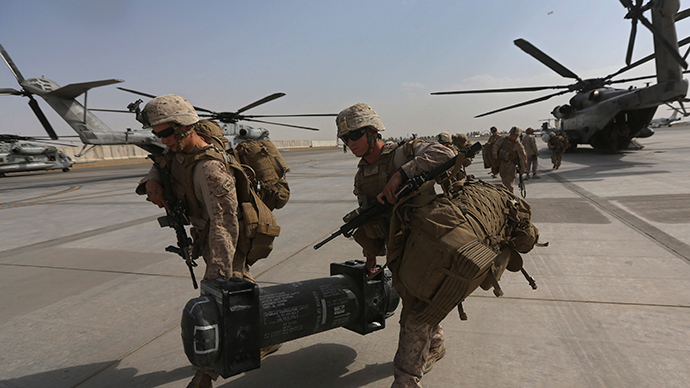Lost & Found: Did ISIS ‘find’ $420mn in ‘lost’ US military supplies in Afghanistan?

How does the military lose half a billion dollars worth of equipment in one year? That’s the question Pentagon auditors are asking after it was revealed that US military equipment worth $420 million went missing in action in Afghanistan last year.
According to a recent Pentagon report, 156,000 pieces of hardware, including sophisticated weapons systems, vehicles and communications gear vanished into thin air in fiscal year 2013. The report also revealed that between 2006 and 2010, 133,557 pieces of equipment valued at $238.4 million could not be accounted for.
No matter how you slice it, that’s a lot of military hardware slipping out the back door. And since we are talking about the US Army here, where no general wants to lose a star or two over the question of inventory, it stands to reason that the figures have been greatly scaled back.
Karen Kwiatkowski, a retired US Air Force Lieutenant Colonel, confirmed the suspicion when she told RT “there’s probably a lot more missing than what’s been reported by this Inspector General’s report.”
So now the billion dollar question: Who has got their grimy hands on America’s top-shelf military hardware from Afghanistan? If all that equipment was sold or stolen, it would eventually appear on the radar. And perhaps it already has.
A likely culprit in this great American weapons heist is Islamic State, formerly known as al-Qaeda in Iraq, the motley crew of ultraviolent cutthroats that rose out of the Iraqi desert at precisely the same time that US hardware in Afghanistan was disappearing from the shelf like it was Black Friday at Wal-Mart.
The curious thing about Islamic State is how this group, which is apparently so vicious that even al-Qaeda alienated them, suddenly emerged on the scene last year, and at almost precisely the same time the Obama administration suddenly braked hard on what appeared to be an ironclad decision to invade the Syrian government of President Bashar Assad. America’s Commander-in-Chief, who has never waited in the past for congressional consent to initiate a military offensive (7 offensives to date for the Nobel Prize winner with still two years left to go), this time left the decision to Congress.

The reason for the last-minute change of tactic was not due to prudence on Obama’s part, or some kind of respect for the trampled Constitution, but rather the understanding that taking sides in the Syrian civil war was a bad public relations move since al-Qaeda was also allied with the Syrian rebels against the Assad government.
Senator Ted Cruz, who, in a moment of impressive perceptiveness for an American politician, summed up the situation best.
“We certainly don’t have a dog in the fight,” Cruz said, echoing the timeless message of Ron Paul. “We should be focused on defending the United States of America. That’s why young men and women sign up to join the military, not to, as you know, serve as al-Qaeda’s air force.”
Meanwhile, there was also the nagging problem of Syria’s chemical weapons arsenal. It goes without saying that bombarding a country bubbling with large stocks of chemical weapons may not be the best way of supporting your rebel allies, who are on the ground in the thick of it. Thus, US Secretary of State John Kerry diplomatically, if not cunningly, suggested that Washington would call off the dogs if Bashar Assad would hand over his stock of chemical weapons in “one week.”
Russia successfully intervened and the unenviable task of removing Syria’s chemical weapons was eventually assumed by the United Nations. Today, Syria is without its chemical weapons – the poor man’s equivalent of nuclear weapons - but that does not mean Washington is content with Assad – an ally of the Iranian regime (which in all likelihood is the Endgame here) - still hanging around. In fact, Washington has openly stated its intentions of assisting the rebels to usurp the elected leader of Syria. But without the chemical casus belli for military intervention in Syria, Washington needed a new strategy to jump into the fray.
So guess what magically appeared on the desert horizon, motoring along with a head of steam in an endless convoy of Toyota Tacoma pickup trucks and sophisticated weapons - the very same brand of merchandise that went mysteriously AWOL in Afghanistan? Yes, the bad boys of Islamic State, whose highly publicized video beheadings of several American and British journalists handed Washington the opportunity to do what it could not do just one year earlier: launch attacks on Syria territory.

Admittedly, the US military, from what we are being told, has thus far practiced restrained self-control in Syria and not gone off the rails with an attack on Syrian government forces. But that’s not to say that the Pentagon’s “defensive strategy” today will not abruptly morph into an all-out offensive against Assad’s forces tomorrow. Indeed, it is the opinion here that only a miracle will prevent such a disastrous scenario from happening.
Unfortunately, news of America’s activities in Syria is being tightly controlled by the US military, which has given up the practice of “embedded journalism” in the ranks after a few media mavericks, like the late Michael Hastings of Rolling Stone fame, took one too many liberties with their “privileges.” To put it another way, they could not be “trusted."
Meanwhile, the aerial campaign against the barbaric Islamic State seems to have taken a backseat as the US military goes on a joyride around Syria, seemingly hunting for anything but members of IS.
Just yesterday, the US aerial campaign targeted new Syrian territory in the northwest of the country, this time hitting a compound belonging to the al-Nusra Front, and despite the fact this group is equally opposed to the Islamic State. It was also reported that a compound belonging to the Islamic group Ahrar al-Sham in Syria’s northwestern territory came under American attack, according to the British-based Syrian Observatory for Human Rights.
On Friday, the US military announced it carried out air strikes against the al-Qaeda-linked Khorasan group, an organization few people had heard of before the aerial campaign began in Syria. According to military officials, US forces targeted several vehicles and buildings near the border with Turkey.
Increasingly, and oddly, the allegedly ruthless Islamic State seems to be falling out of the equation in Syria as a host of other lesser known groups are becoming the target of the US-led aerial campaign. This is having the effect of confusing the situation in Syria to the point that few people understand what is happening. When and if the US attacks Syrian government forces this dust being thrown into the public's face will have served its purpose.
Of course I hope I am wrong, but it appears only a matter of time before the Syria campaign, initially against Islamic State, will start to resemble the former war in Iraq, carved up with no-fly zones and massive bombardments and the eventual toppling of Damascus.
At that point, nobody will remember the name Islamic State, nor the loss of US military equipment from Afghanistan.
Robert Bridge is the author of the book, Midnight in the American Empire, which details the dangerous consequences of excessive corporate power in the United States.
The statements, views and opinions expressed in this column are solely those of the author and do not necessarily represent those of RT.
The statements, views and opinions expressed in this column are solely those of the author and do not necessarily represent those of RT.













